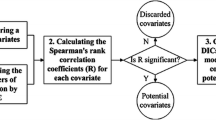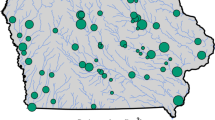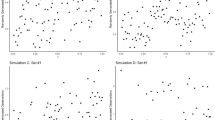Abstract
Some recent research on fluvial processes suggests the idea that some hydrological variables, such as flood flows, are upper-bounded. However, most probability distributions that are currently employed in flood frequency analysis are unbounded to the right. This paper describes an exploratory study on the joint use of an upper-bounded probability distribution and non-systematic flood information, within a Bayesian framework. Accordingly, the current PMF maximum discharge appears as a reference value and a reasonable estimate of the upper-bound for maximum flows, despite the fact that PMF determination is not unequivocal and depends strongly on the available data. In the Bayesian context, the uncertainty on the PMF can be included into the analysis by considering an appropriate prior distribution for the maximum flows. In the sequence, systematic flood records, historical floods, and paleofloods can be included into a compound likelihood function which is then used to update the prior information on the upper-bound. By combining a prior distribution describing the uncertainties of PMF estimates along with various sources of flood data into a unified Bayesian approach, the expectation is to obtain improved estimates of the upper-bound. The application example was conducted with flood data from the American river basin, near the Folsom reservoir, in California, USA. The results show that it is possible to put together concepts that appear to be incompatible: the deterministic estimate of PMF, taken as a theoretical limit for floods, and the frequency analysis of maximum flows, with the inclusion of non-systematic data. As compared to conventional analysis, the combination of these two concepts within the logical context of Bayesian theory, contributes an advance towards more reliable estimates of extreme floods.










Similar content being viewed by others
Abbreviations
- LB:
-
Lower-bounded floods as referring to the floods that are larger than a given low threshold LB
- UB:
-
Upper-bounded floods as referring to the floods that are smaller than a given high threshold UB
- DB:
-
Double-bounded floods as referring to the floods that are comprised within the discharge interval (LR, UR)
- EX:
-
Annual flood-peaks with exact values
- α :
-
Upper bound of the LN4 distribution
- ε :
-
Lower bound of the LN4 distribution
- σ Y :
-
Scale parameter of the LN4 distribution
- μ Y :
-
Location parameter of the LN4 distribution
- ρ:
-
Scale parameter of the prior distribution of parameter
- β:
-
Shape parameter of the prior distribution of parameter
- μ μ :
-
Location parameter of the prior distribution of parameter μ
- σ μ :
-
Scale parameter of the prior distribution of parameter μ
- ρ σ :
-
Scale parameter of the prior distribution of parameter σ
- β σ :
-
Shape parameter of the prior distribution of parameter σ
References
Baker VR (1987) Paleoflood hydrology and extraordinary flood events. J Hydrol 96:79–99
Baker VR (2003) A bright future for old flows: origin, status and future of paleoflood hydrology. In: Thorndycraft VR, Benito G, Barriendos M, Llasat MC (eds) Proceedings of 2002 PHEFRA workshop—palaeofloods, historical floods and climatic variability: applications in flood risk assessment, Chap 2, pp 13–18. http://www.ccma.csic.es/dpts/suelos/hidro/images/chapter_02_phefra.pdf
Baker VR, Webb RH, House PK (2002) The scientific and societal value of paleoflood hydrology. In: House PK, Webb RH, Baker VR, Levish DR (eds) Ancient floods, modern hazards, principles and applications of paleoflood hydrology. American Geophysical Union Water Science and Application Series, Washington, pp 1–19
Bernardara P, Schertzer D, Sauquet E, Tchiguirisnkaia I, Lang M (2008) The flood probability distribution tail: how heavy is it? Stoch Environ Res Risk Assess 22:107–122. doi:10.1007/s00477-006-0101-2
Botero BA (2006) Estimación de crecidas de alto período de retorno mediante funciones de distribución con límite superior e información no sistemática. PhD Thesis, Universidad Politécnica de Valéncia, Spain
Coles SG, Powell EA (1996) Bayesian methods in extreme value modeling: a review and new developments. Int Stat Rev 64(1):119–136
Dawdy DR, Lettenmaier DP (1987) Initiative for risk-based flood design. J Hydrol Eng 113(8):1041–1051
Dubler JR, Grigg NS (1996) Dam safety policy for spillway design floods. J Prof Issues Eng Educ Pract 122(4):163–169
Elíasson J (1997) A statistical model for extreme precipitation. Water Resour Res 33(3):449–455
Enzel Y, Ely LL, House PK, Baker VR, Webb RH (1993) Paleoflood evidence for a natural upper bound to flood magnitudes in the Colorado River Basin. Water Resour Res 29(7):2287–2297
FEMA—Federal Emergency Management Agency (2004) Federal guidelines for dam safety: selecting and accommodating inflow design floods for dams. The Interagency Committee of the U. S. Department of Homeland Security, Washington, DC
Francés F (2001) Incorporating non-systematic information to flood frequency analysis using the maximum likelihood estimation method. In: Glade T, Albini P, Francés F (eds) The use of historical data in natural hazard assessments, Chapter B: Flooding. Kluwer Academic Publishers, Dordrecht, pp 89–99
Francés F, Botero BA (2003) Probable maximum flood estimation using systematic and non-systematic information. In: Thorndycraft VR, Benito G, Barriendos M, Lllasat MC (eds) Proceedings of 2002 PHEFRA workshop—palaefloods, historical floods and climatic variability: applications in flood risk assessment, Chap 34, pp. 223–229. http://www.ccma.csic.es/dpts/suelos/hidro/images/chapter_34_phefra.pdf
Francés F, Salas JD, Boes DC (1994) Flood frequency analysis with systematic and historical or paleoflood data based on the two parameter general extreme values models. Water Resour Res 30(6):1653–1664
Gilks WR, Richardson S, Spiegelhalter DJ (1996) Markov chain Monte Carlo in practice. Chapman & Hall/CRC, London, UK
Hershfield DM (1965) Method for estimating maximum probable precipitation. J Am Waterworks Assoc 57:965–972
Hirsch RM, Stedinger JR (1987) Plotting positions for historical floods and their precision. Water Resour Res 23(4):715–727
Hirschboeck K (2003) Floods, paleofloods, and droughts: insights from the upper tails. In: CLIVAR/PAGES/IPCC Workshop—a multi-millennia perspective on droughts and implications for the future, Tucson, AZ. Available at http://ipcc-wg1.ucar.edu/meeting/Drght/materials/abstracts/Hirschboeck.pdf
Horton RE (1936) Hydrologic conditions as affecting the results of the application of methods of frequency analysis to flood records. U. S. Geol. Surv Water Supply Paper No. 771, pp 433–449
Hosking JRM, Wallis JR (1997) Regional frequency analysis—an approach based on L-moments. Cambridge University Press, Cambridge
Houghton J (1978) Birth of a parent: the Wakeby distribution for modeling flood flows. Water Resour Res 15(6):1361–1372
IACWD—Interagency Advisory Committee on Water Data (1985) Feasibility of assigning a probability to the probable maximum flood. Office of Water Coordination, Washington, DC
ICOLD—International Commission of Large Dams (1987) Bulletin 59—dam safety guidelines, Paris, France
Jacoby Y, Grodek T, Enzel Y, Porat N, McDonald EV, Dahan O (2008) Late holocene upper bounds of flood magnitudes and twentieth century large floods in the ungauged, hyperarid alluvial Nahal Arava, Israel. Geomorphology 95(3–4):274–294
Kanda J (1981) A new extreme value distribution with lower and upper limits for earthquake motions and wind speeds. Theor Appl Mech 31:351–360
Klemeš V (1987) Hydrological and engineering relevance of flood frequency analysis. In: Proceedings of international symposium on flood frequency risk analysis–regional flood frequency analysis, Baton Rouge, LA. D. Reidel Publishing Company, Boston, MA, pp 1–18
Klemeš V (1993) Probability of extreme hydrometeorological events—a different approach. In: Proceedings of Yokohama symposium on extreme hydrological events: precipitation, floods and droughts. IAHS Publ. 213, pp 167–176
Koutsoyiannis D (1999) A probabilistic view of Hershfield’s method for estimating probable maximum precipitation. Water Resour Res 35(4):1313–1322
Lunn DJ, Thomas A, Best N, Spiegelhalter D (2000) WinBUGS—a Bayesian modelling framework: concepts, structure, and extensibility. Stat Comput 10:325–337
Martins ES, Stedinger JR (2000) Generalized maximum-likelihood generalized extreme-value quantile estimators for hydrologic data. Water Resour Res 36(3):737–744
McRobbie A (2004) The Bayesian view of extreme events. In: Proceedings of Henderson colloquium: designing for the consequences of hazards. The Institution of Structural Engineers, London, UK. Available at http://www.istructe.org/IABSE/db/599.asp
Micevski T, Kuczera G (2009) Combining site and regional flood information using a Bayesian Monte Carlo approach. Water Resour Res 45:W04405. doi:10.1029/2008WR007173
Migon HS, Gamerman D (1999) Statistical inference: an integrated approach. Hodder Arnold, London
Nathan RJ, Weinmann PE (2001) Estimation of large and extreme floods for medium and large catchments: book VI. Australian rainfall and runoff—a guide to flood estimation, 4th edn. Engineers Australia, National Committee for Water Engineering, Australia
Naulet R (2002) Utilisation de l’information des crues historiques pour une meilleure prédétermination du risque d’inondation. Application au bassin de l’Ardèche à Vallon Pont-d’Arc et St-Martin d’Ardèche. PhD Thesis, INRS-ETE, Grenoble, France
NRC–National Research Council (1999) Improving American river flood frequency analysis. National Academy Press, Washington, DC
O’Connell DRH, Ostenaa DA, Levish DR, Klinger RE (2002) Bayesian flood frequency analysis with paleohydrologic bound data. Water Resour Res 38(5):16.1–16.13
Reis D, Stedinger JR (2005) Bayesian MCMC flood frequency analysis with historical information. J Hydrol 313:97–116
Renard B, Lang M, Bois P (2006) Statistical analysis of extreme events in a non-stationary context via a Bayesian framework: case study with peak-over-threshold data. Stoch Environ Res Risk Assess 21:97–112. doi:10.1007/s00477-006-0047-4
Sisson SA, Pericchi LR, Coles SG (2006) A case for reassessment of the risks of extreme hydrological hazards in the Caribbean. Stoch Environ Res Risk Assess 20:296–306. doi:10.1007/s00477-005-0246-4
Slade JJ (1936) An asymmetric probability function. Trans Am Soc Civ Eng, vol 101, Paper No. 1924, pp 35–61
Stedinger JR, Cohn TA (1986) Flood frequency analysis with historical and paleoflood information. Water Resour Res 22(5):785–793
Stedinger JR, Heath DC, Thompson K (1989) Risk analysis for dam safety evaluation. Report TCN 87-653 prep. for the U. S. Army Corps of Engineers
Takara K, Loebis J (1996) Frequency analysis introducing probable maximum hydrologic events: preliminary studies in Japan and in Indonesia. In: Proceedings of international symposium on comparative research on hydrology and water resources in Southeast Asia and the Pacific. Indonesian National Committee for International Hydrological Programme, pp 67–76
Takara K, Tosa K (1999) Storm and flood frequency analysis using PMP/PMF estimates. Proc. International symposium on floods and droughts, Nanjing, China, pp 7–17, IHP-V Technical Documents in Hydrology No. 4, UNESCO Jakarta Office, Hohai University Press
USACE—United States Army Corps of Engineers (2001) American River Basin, California, Folsom Dam and Lake Revised PMF Study—Hydrology Office Report. U.S. Army Corps of Engineers, Sacramento District, CA
USBR—United States Bureau of Reclamation. (2004) Hydrologic hazard curve estimating procedures. Research Report DSO-04-08, U.S. Bureau of Reclamation, Denver, CO
USBR—United States Bureau of Reclamation (2002) Flood hazard analysis, Folsom Dam Central Valley Project. Flood Hydrology Group, Denver, CO
USNRC—U.S. Nuclear Regulatory Commission (1977) Design Basis Floods for Nuclear Power Plants. Regulatory Guide 1.59, Washington, DC
Vick SG (2002) Degrees of belief—subjective probability and engineering judgment. ASCE Press, Reston, VA
Vogel RM, Matalas NC, England JF, Castellarin A (2007) As assessment of exceedance probabilities of envelope curves. Water Resour Res 43(7), W07403. doi:10.1029/2006WR005586
WMO—World Meteorological Organization (1986) Manual for estimation of probable maximum precipitation, 269 pp. Operational Hydrology Report 1, WMO 332, Geneva, Switzerland
Yevjevich V (1968) Misconceptions in hydrology and their consequences. Water Resour Res 4(2):225–232
Yevjevich V, Harmancioglu NB (1987) Some reflections on the future of hydrology. In: Proceedings of Rome symposium on water for the future: hydrology in perspective, IAHS Publ. 164. International Association of Hydrological Sciences, Wallingford, UK, pp 405–414
Acknowledgements
The authors wish to acknowledge the support to this research from FAPEMIG (“Fundação de Amparo à Pesquisa do Estado de Minas Gerais”), through grant CRA APQ 4683-5.04/07 (PPM), and from CNPq (“Conselho Nacional de Desenvolvimento Científico e Tecnológico”), through grants 305870/2006-8, 304505/2006-4, 472877/2006-2, and a scholarship for W. Fernandes. The authors also wish to thank the anonymous reviewers for their valuable comments and suggestions.
Author information
Authors and Affiliations
Corresponding author
Rights and permissions
About this article
Cite this article
Fernandes, W., Naghettini, M. & Loschi, R. A Bayesian approach for estimating extreme flood probabilities with upper-bounded distribution functions. Stoch Environ Res Risk Assess 24, 1127–1143 (2010). https://doi.org/10.1007/s00477-010-0365-4
Published:
Issue Date:
DOI: https://doi.org/10.1007/s00477-010-0365-4




